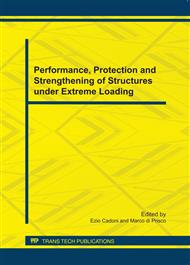p.509
p.515
p.521
p.527
p.533
p.539
p.545
p.551
p.559
Bond Models for FRP Bars Anchorage in Concrete Slabs under Fire
Abstract:
Experimental tests were recently performed to evaluate resistance and deformability of nine concrete slabs reinforced with Fiber Reinforced Polymer (FRP) bars in fire situation by varying (a) external loads in the range of the service loads, (b) concrete cover in the range of usual values (30-50mm), (c) bar end shape (straight or bent) and its length at the end of the concrete members, namely in the zone not directly exposed to fire (250-500mm). Experimental results showed the importance of concrete cover in the zone directly exposed to fire for the protection provided to FRP bars, due to its low thermal conductivity. Moreover, the length of the FRP bars in the zone of slab not directly exposed to fire and its shape at the end of the members was crucial to ensures slab resistance once the resin softening reduced the adhesion at the FRP-concrete interface in the fire exposed zone of slab. In particular the anchorage obtained simply by bending bars at the end of member in a short zone (250mm) allowed attaining a good structural behavior in case of fire equivalent to that showed by slabs characterized by a large anchoring length (500mm). Tests results are briefly compared and discussed in this paper, whereas the behavior of the bar anchorage is carefully examined based on both the results of numerical thermal analysis and the predictions of a bond theoretical model adjusted for fire situation.
Info:
Periodical:
Pages:
533-538
Citation:
Online since:
July 2011
Keywords:
Price:
Сopyright:
© 2011 Trans Tech Publications Ltd. All Rights Reserved
Share:
Citation:


